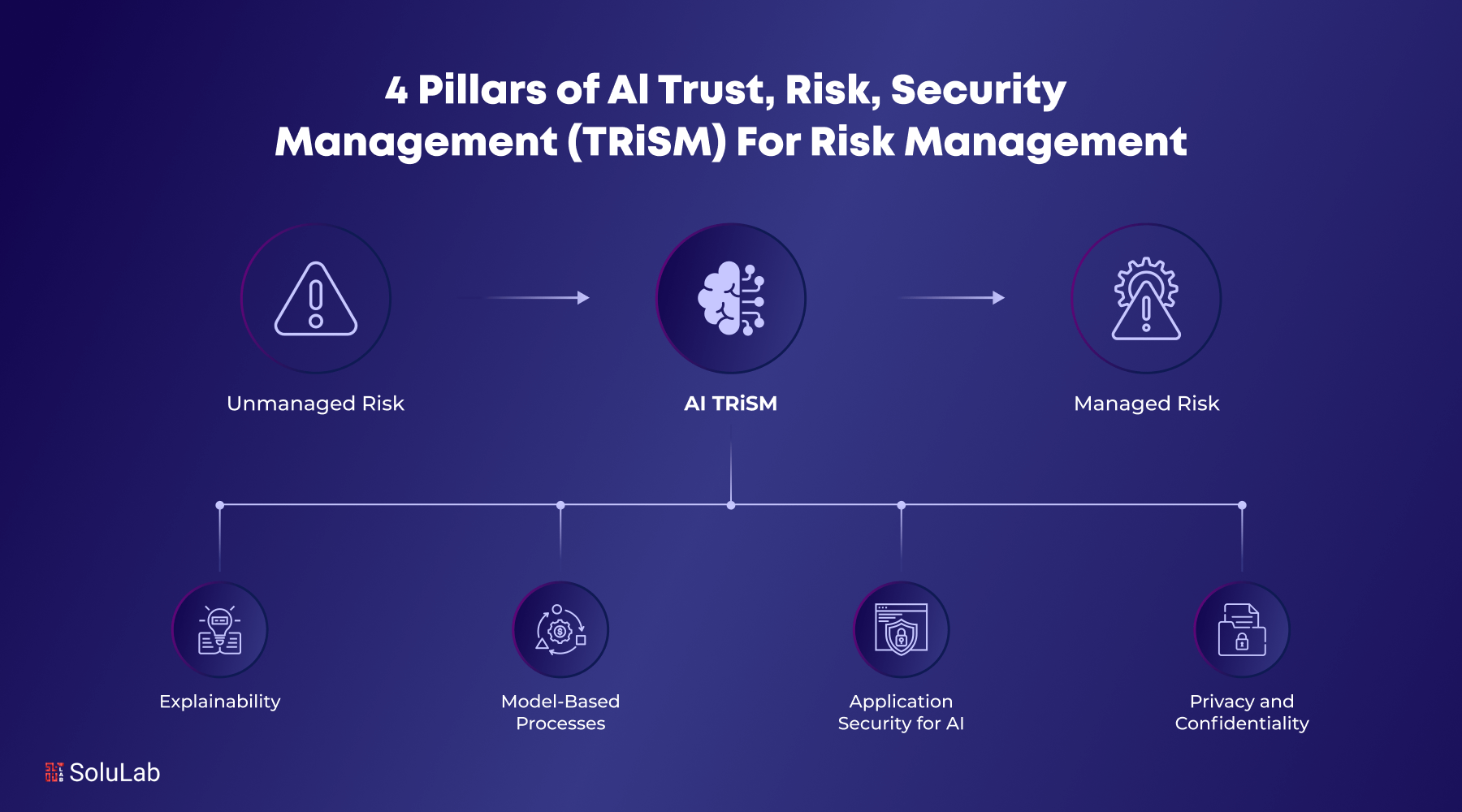
Gartner developed the term AI TRiSM, which is a framework for finding and constraining security, trust, and reliability issues in AI models and their applications for enterprises. AI TRiSM is a risk, security, and trust management acronym. Organizations are adopting AI at an increasingly fast pace for a wide range of uses as practical applications expand. However, the area that falls behind is governance, in this case, specifically security and privacy.
AI trust, risk, and security, or AI TRiSM, ensures the confidentiality, integrity, availability, non-manipulation, and other things about AI models, such as data security, model operations, adversarial resistance, and interpretability and expandability. The AI TRiSM framework serves as a guide toward the identification, monitoring, and mitigation of potential risks related to the use of AI technology by any given enterprise, including the increasingly ubiquitous AIs that are generative and adaptive. This architecture enables organizations to guarantee adherence to all applicable rules and data privacy regulations. In the article below, you will learn what AI TRiSM is, the main pillars of AI TRiSM, Major Use Cases, the framework of AI TRiSM, Benefits, and 3 major challenges AI TRiSM faces.
What Does AI TRiSM Mean?
Gartner defines AI TRiSM as the framework for protecting efficacy, robustness, fairness, trustworthiness, and reliability in AI models. The technological trend provides guidelines on how potential risks associated with the deployment of AI models can be restrained as well as how those risks can be spotted. As a result, companies will be in a better position to determine that decisions are aligned with trusted sources of data and actualized process results, which are actualized and possible for any given activity.
This aims to make AI TRiSM implementable in the future with foresight. It presents various models and best practices for risk identification and governance concerning AI, therefore ensuring that businesses pay attention to the ethical, legal, and security implications. In addition to this, AI TRiSM promotes the design of a governance structure that embeds responsibility and accountability when applying AI.
Businesses can interact with security experts and solutions suppliers through AI TRiSM, which safeguards critical networks and data. Since the model is accurate, Gartner shows that businesses with AI use cases and implementing the framework can have a 50% increase in adoption rates.
How Can Businesses Make Use of TRiSM?
The AI-created models are susceptible to hacking; that is, fraudsters can exploit AI models as an attack for automating and scaling malevolent processes such as:
- Malware Attacks
- Data Leaks
- Phishing Programs
In the first half of 2022, nearly 236.1 million ransomware attacks took place across the globe, a steep rise compared to the previous year. This is because new technology has been welcomed without cautionary measures. This is where AI TRiSM comes in, allowing companies to use AI models safely and securely. Its framework includes methods that can be the safe base for AI models.
AI TRiSM ensures the right results are generated from AI models by incorporating such safeguards as data encryption, secure storing of data, and multi-factor authentication when accessing and deploying AI models. Similarly, companies can concentrate on exploiting these models to fuel growth, productivity, and improved customer experience by providing AI with a safe space. They can also reach their upgraded goals.
For instance, AI TRiSM offers an automated method of researching customers’ data so that firms can establish patterns and opportunities to come up with better products and services.
If you hire an AI developer, your business can leverage the power of machine learning algorithms and advanced analytics applied to its data to find trends and insights to maximize the value of that same data.
Business organizations can apply AI TRiSM to help make interaction with security experts and solution providers easier with AI TRiSM so that safety for vital networks and data is assured.
Pillars and Framework of TRiSM
There are four pillars of the structure of the AI TRiSM framework and the order in which the framework is structured is as;
- Model Monitoring or Explainability
- Model-Based Processes
- Application Security for AI
- Privacy and Confediality
By following these four pillars of the framework, your company may enjoy the newly emerging technologies in artificial intelligence and also gain the trust of its clients.
1. Explainability
Model monitoring and explainability aim to make AI applications more transparent such that the AI models can give clear reasons for the choices or predictions they are making. Model monitoring simply means doing regular checks on the AI models to ensure that biases are not being introduced and the AI works as intended. This contributes to our understanding of how the AI models function and what makes it make particular choices.
2. Model-Based Processes
Creating procedures and frameworks for managing AI models at every stage of their lifecycle- from creation and implementation to upkeep is known as model operations. This relates to the ongoing testing, updating, and refinement of an AI model following its deployment. ModelOps also includes maintaining the underlying environment and infrastructure, including cloud resources, to make sure the models function as best they can.
3. Application Security for AI
Application security is crucial since AI models frequently work with sensitive data any security lapses in the cloud have determined effects. Models are safe and shielded from cyberattacks by AI security. Thus, companies can create security policies and procedures to prevent unwanted access or manipulation using TRiSM’s architecture.
4. Privacy and Confidentiality
Maintaining operational integrity, guaranteeing user privacy, and adhering to laws like the GDPR all depend on the protection of this data. Data protection ensures that the information used by AI systems is kept safe, secure, and shielded from unauthorized access and breaches. This is becoming crucial in sectors like healthcare, where various AI models are used to process sensitive patient data.
AI TRiSM Major Use Cases and Examples

For enterprises implementing enterprise AI to properly manage and mitigate risks, AI TRiSM frameworks are essential. The following are the major sectors that are using this AI TRiSM framework and an AI TRiSM example for better understanding:
Case Study For Example
The Danish Business Authority DBA sought to ensure that its AI models were accountable, transparent, and most importantly fair. Hence, it adopted a procedure of integrating corporation ethical standards into its artificial intelligence algorithms. To do this, DBA has linked its moral values to specific acts, like To do this, DBA has linked its moral values to specific acts, like:
- Checking the results of a model against the fairness tests regularly.
- Beginning the process of what constitutes the model monitoring.
These tactics were used in the deployment and management of a total of sixteen AI models that analyze financial transactions in the bills of billions of Euros. Thus, DBA was able to use this strategy to prove the company’s passive and gain the trust of the stakeholders and consumers, both maintaining the ethical aspect of AI models used by the company.
HealthCare
- Accuracy in Diagnosis: Under AI TRiSM, ongoing testing and monitoring guarantees that AI in healthcare diagnosis tools continue to be accurate and dependable and also reduces the possibility of incorrect diagnoses brought on by model drifts and bias.
- Managing Patient Data: The framework involved in AI TRiSM guarantees HIPAA compliance, safeguards private patient information, and increases patient confidence.
Banking and Financial Services
- Regulatory Compliance: AI TRiSM is mainly used in compliance by financial sectors so that they can easily change requirements like the Fair Credit Reporting Act and the GDPR. To comply with regulatory requirements automation of procedures is done for assessing risk involved.
- Detection of Fraud Activities: Creating AI-powered fraud detection systems that are extremely accurate and can act morally requires the framework of AI TRiSM. It can aid in the detection of suspicious transactions,
Institutional
- Adaptable Education Systems: AI TRiSM makes sure AI-powered adaptive learning solutions work fairly and openly, enhancing learning outcomes impartially.
- Data Security: AI TRiSM can also comply with the ethical and legal requirements for data privacy while safeguarding the sensitive information shared by the students.
E-Commerce and Retail
- Supply Chain Optimization: Using AI TRiSM for monitoring the conversational AI applications involved in supply chain logistics, one can easily detect biases and hazards and ensure efficient as well as equitable solutions.
- Personalized Experiences: AI TRiSM solutions enable you to comprehend the moral use of AI for personalizing customer experiences and ensuring that the consumer profiling and processing of their data comply with privacy regulations.
Integration of AI TRiSM’s Framework
The implementation of these pillars into practice creates the AI TRiSM framework which increases the chance of security, dependability, and efficacy of AI. This all-encompassing strategy ensures that:
- AI systems are quite open and this helps many people to comprehend how the systems got to certain conclusions thereby fostering trust.
- The machine learning models follow their development deployment and retirement life cycle to make sure that they remain useful at all times.
- As it will be said further during the discussion of augmentation, high data integrity is critical in guaranteeing objectivity in the results produced by artificial intelligence and thus it is strictly guaranteed.
- Security threats are avoided to have an impact on the AI systems thereby retaining credibility.
- Compliance with the criteria of the global level standards for the usage of data protection and privacy.
Regarding specific risk areas concerning AI implementation, every concept in the AI TRiSM framework enables organizations to leverage AI solutions without suffering losses. The systematic way applied to the governance of AI leads to higher quality work and to the development of an environment that is not only ethically and legally sound.
Can AI TRiSM promise Secure and Responsive AI?
AI Trust, Risk, and Securit management is another emerging perspective for ensuring that responsible AI services are secure, dependable, and capable of understanding the requirements of users and other interested parties. It is therefore said that due to the complexity of the integration of AI TRiSM technology in various industries, the risk and security issues can be best handled in a systematic order as more and more industries are leveraging the technology. To avoid these setbacks in AI TRiSM use cases it has put measures that would enhance accountability, reporting, and compliance with the law. Here are some main key points that cover how AI TRiSM promises secure and responsive AI:
- Decreased Risks and Enhanced Security: AI models are vulnerable to biases and cyberattacks. By putting security procedures in place and guaranteeing impartiality in decision-making, AI TRiSM assists in identifying and reducing these threats. This could also result in AI models that are safer and more dependable, shielding companies from possible harm.
- Gaining Stakeholders’ Trust: Developing trust requires transparency, AI TRiSM encourages explainable AI which are the models that can give precise justifications for the choices they make. Establisihng trust with consumers, employees, and regulators facilitates the use of AI by enterprises giving them more confidence to use it.
- Maximized Business Value: Organizations can fully utilize AI technology by concentrating on ethical AI development. Businesses may use sensitive data safely thanks to AI TRiSM’s assurance of data protection and compliance, which eventually improves decision-making, efficiency, and customer experiences.
Key Benefits of Implementing AI TRiSM
With its capability to comprehend data, AI TRiSM enables businesses to make use of artificial intelligence with greater rigor. Started differently, it effectively bypasses a data protection filter, enabling optimal regulation of AI solutions.
| Feature | Description |
Increased Efficiency of Businesses |
Simply process with a streamlined workflow This kind of performance of business processes streamlines operations thus reducing operating costs due to increased efficiency. Firms can scale down the extent of their direct involvement and focus on such core efforts on growth and more innovation. |
Better Business Processes |
High-quality analysis of decision-making and process management has led to enhanced efficiency and shorter cycle times of the various tasks accomplished. This enables the employees to spend more time on crafted work and fosters innovation and more perfection. |
Adherence to Safety |
to monitor the compliance checks within Artificial Intelligence Systems so that the firms do not violate the relevant laws and safety standards. It can allow the business to decline the probability of non-compliance in the firstly and, as a result, prevent fines and legal issues. Higher compliance ensures ethical practices and a sound culture of the business organization. |
Boost Company Image |
organizations can express their commitment to security, openness, and ethical AI practices. Such an approach adds value to the company and the industry as a whole by developing trust from the customers. It means that simply more customers, partners, and investors, who value ethical business behavior, are attracted to companies with a good reputation. |
Improved Reliability |
By the continual tracking of the data sources coupled with the assessment of the results, organizations can make sound decisions using correct information. And thus this dependability enhances stakeholder confidence in the organizations’ data-driven strategy. |
3 Major Challenges AI TRiSM May Face
Even though AI TRiSM offers plenty of benefits as mentioned above, the framework also faces some challenges during the implementation. Here are the notable challenges one should not miss knowing about:
-
Security of Data
Due to the AI and ML in data integration systems’ heavy reliance on data, data privacy presents major issues for AI TRiSM. Serious ramifications from data breaches can include losing the trust of customers and facing legal implications. Organizations should put strong data governance structures in place and establish strict guidelines for gathering, storing, and using data. Regular audits and encryption controls can assist in the reduction of threats to data.
-
Biases of Algorithms
In AI TRiSM, algorithmic bias presents a big obstacle. Biases built into AI models may produce unjust results, enhancing inequality and eroding public confidence in AI systems. Organizations should keep a close eye out for the biases in AI systems to fix these issues.
-
Moral Aspects
Implications for ethics are another difficulty faced in the implementation of AI TRiSM is decision-making and other issues like accountability and distance. To avoid foreseen outcomes, the societal impact of AI’s decisions must be carefully considered. To better comprehend how AI models generate decisions, businesses can employ explainable AI strategies. It is easier to control expectations and encourage moral AI use when AI capabilities and restrictions are made clear.
Explore How SoluLab Can Transform Your AI Models
The very optimization of your AI solutions’ potential might only require the cooperation with a reliable AI development company such as SoluLab given the fact that AI is growing in prominence and across industries and new opportunities are gradually appearing. As a result, with the help of AI TRiSM, SoluLab can ensure the safety and reliability of AI models in addition to meeting moral standards by helping you adopt AI solutions with confidence.
With the help of SoluLab, organizations will be able to minimize risks and ensure compliance as well as build trust among the stakeholders. The creation of your new AI models or the enhancement of the existing ones will be made easier by the team of professionals at SoluLab.
As a step forward towards leveraging AI for your company enhance your AI models to achieve more benefits. Contact AI consulting company SoluLab now.
FAQs
1. What is AI TRiSM?
AI TRiSM stands for trust, risk, and security management. Organizations are embracing AI for better development and functioning for a wide range of purposes.
2. What are the examples of AI?
AI is being used for everyday tasks which include text editing, online shopping, search engines, digital assistants, fraud prevention, etc.
3. How many pillars are there in AI TRiSM?
Mainly there are 5 pillars in the framework of AI TRiSM which are explainability, modelOps, data integrity, privacy, and model-based process.
4. What are AI Algorithms?
AI algorithms are a set of guidelines that are supposed to be used while performing calculations or other tasks.
5. Can SoluLab Build AI for Businesses?
Solulab’s services encompass from computer vision to natural language processing that ensures smart and effective systems using AI technologies.






